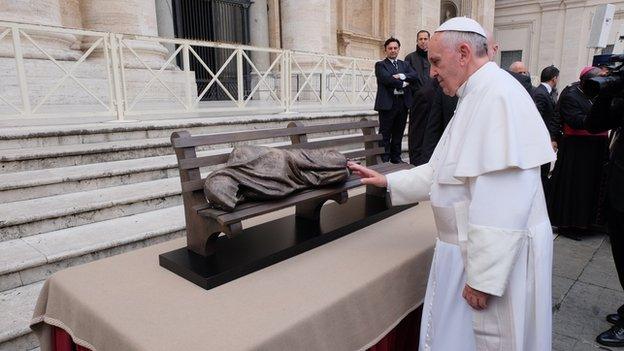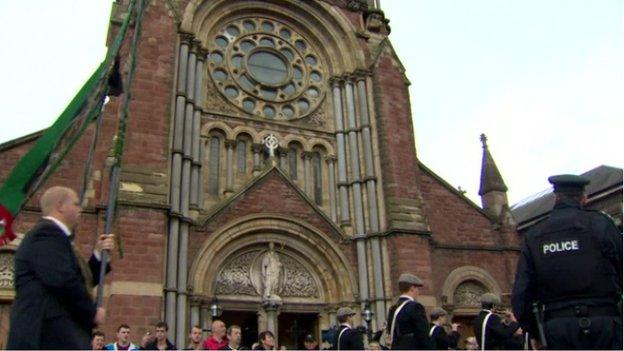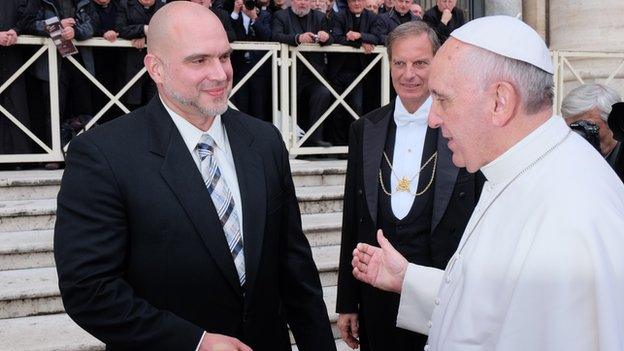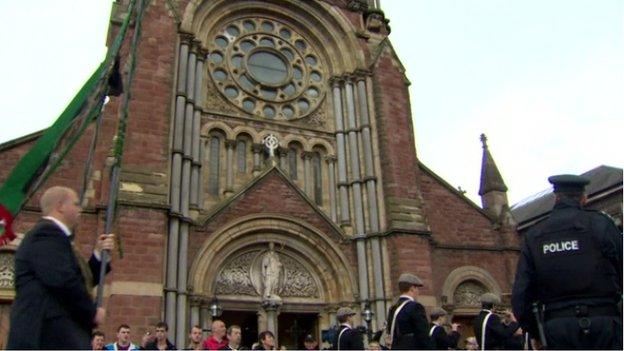Tim Schmalz seeks home for his Homeless Jesus
- Published
-copy.jpg)
Tim Schmalz's full-size bronze status of Jesus, the Homeless
At first glance, you see someone huddled in blankets and clutching at sleep on a cold park bench.
At second glance, you think: "It's a statue."
At third glance, you notice the holes in the feet - where the nails went in that nailed him to the cross.
Jesus, the Homeless, is a life-size bronze statue that has divided opinion in America and England.
Some people love the Banksy feel of it - the sense of art for the people, reaching out to the individual on street corners and parks.
Others consider it an insult to the figure of Christ Jesus - leaving him out in the rain. They considered it "insulting" and "demeaning".
It is the work of Canadian sculptor Tim Schmalz, inspired by a glance sideways as he drove along a busy street in Toronto.

Pope Francis blesses a scaled-down version of the statue in Rome
"I was driving into the biggest city in Canada and along the biggest street. I turned and saw a human form shrouded in blankets in the middle of the day," he said.
"It just shocked me. In that initial moment my experience was of seeing Jesus there."
The image stayed with him and he went home and created Jesus the Homeless.
Now, he is setting about finding him a home and Belfast is on his list.
An anonymous Episcopalian benefactor is funding 12 casts of the statue to go to big cities across the world, free of charge.
Rome is one destination and London is another. But Schmalz has a special place in his heart for Ireland.
A man who was sleeping rough died of hypothermia on the streets of Dublin, close to the Irish parliament in early December.
Now the Irish Times, external is working with the sculptor on a suitable place for the statue. People have been invited to offer their suggestions.
But Belfast, too, is a possibility.
Fr Michael Sheehan who is the administrator of St Patrick's Church in the city's Donegall Street said the sculpture is "unique and inspiring".
"You walk past people sleeping in doorsteps and on park benches. The marks of the two nails on the feet remind us that Christ is present.
"So if you are passing Jesus the Homeless, hopefully you will be reminded that there are others who are in need."
The church would be happy to have it - if the fine details and agreement are reached.
"We have a perfect place for it, between the old church and the old school, the space is open to people coming and going.
"It is a reminder that we are called to serve the homeless and to recognise Christ in each other."
That goes for parading too, said Fr Sheehan.
The street outside St Patrick's became a flashpoint during Orange Order parades in 2012.
This statue would help people to recognise the Christ in each other, Fr Sheehan said.

The street outside St Patrick's Church, Donegall Street, Belfast, became a flashpoint during Orange Order parades in 2012
Also, as the church prepares to celebrate 200 years since its foundation, 2015 would be a perfect year to host Jesus the Homeless, he said.
Tim Schmalz defines himself as a Christian sculptor. In his studio, in the countryside outside Toronto, he works while recordings of the St James' Bible play in the background.
He did not grow up in a religious family, but became committed to Catholicism at 18 and, at one stage, considered becoming a priest.
He did not do so but nevertheless considers that his art and his beliefs go hand-in-hand.
Now he is married with children and works as a sculptor in the countryside outside Toronto.
His work is indelibly bound to his faith. He had a clear plan of what he wanted for Jesus the Homeless.

Sculptor Tim Schmalz with Pope Francis in Rome
"I wanted to make visible what was invisible. Those people [the homeless] are very much invisible, there is no eye contact, no acknowledgement," he said.
In his statue, the face of Jesus is shrouded, but the feet, a very private part of a person, are bare. The statue offers that epiphany moment - when you realise who is depicted.
Sometimes, the dawning is slow.
In North Carolina, a woman called the police on Jesus as what she saw was a homeless person lying out on a park bench.
Some people hate the statue. They object to the depiction of Jesus as a tramp. Their criticism is that Jesus is not a helpless person who needs help. He is the one who gives help.
Others say Jesus should never be represented as a beggar.
But some people love the humanity and the echoes of the gospel that reverberate in the bronze: "Whatsoever you do to the least of my brethren, that you do onto me".
Among those who appeared to love it is Pope Francis. Schmalz presented him with a scale model of his statue at an audience in the Vatican.
The Pope stopped, laid a hand on the statue, closed his eyes, and prayed.
There are plans for a bronze to be placed on the Via della Conciliazione, the great approach to the Vatican.
"It is going to be at a spot close to where a homeless woman died. She was very well loved in that community," said Schmalz.
In London, the offer of the sculpture was turned down by St Martin-in-the-Fields because of a rule banning anyone from sleeping or lying down inside the church. According to the Anglican Church Times, it was felt that given their rule, accepting the statue could leave the church open to ridicule.
There was also a belief that the sculpture objectified the homeless.
Schmalz begged to differ. Now, he said, there is the possibility for the statue to be placed outside the Methodist Central Hall Westminster close to the Houses of Parliament. He would be happy with that.
There was a period of time when Schmalz did not know where his statue would go.
"It sat in a crate for year and I thought about the irony of Jesus the Homeless being homeless," he shrugged.
But that has changed.
In January, Schmalz hopes to travel to Ireland to find suitable locations for his bronze.
Belfast has a place in his heart and he is always open to suggestions for suitable places.
"This is my perspective; If we can use this sculpture to introduce peace and understanding in Belfast, let's try our best, I am game," he said.
On his park bench sculpture, there is a small space - just enough, at a tight squeeze, for one person to sit.
"I made it that way," said Schmalz.
"I deliberately left a little bit of the bench so that you can sit, uncomfortably, beside it."
He would like as many people as possible to sit there and think.
"The power of Christianity is my inspiration," he said.
"Jesus the homeless is my frozen sermon."
- Published12 June 2014
